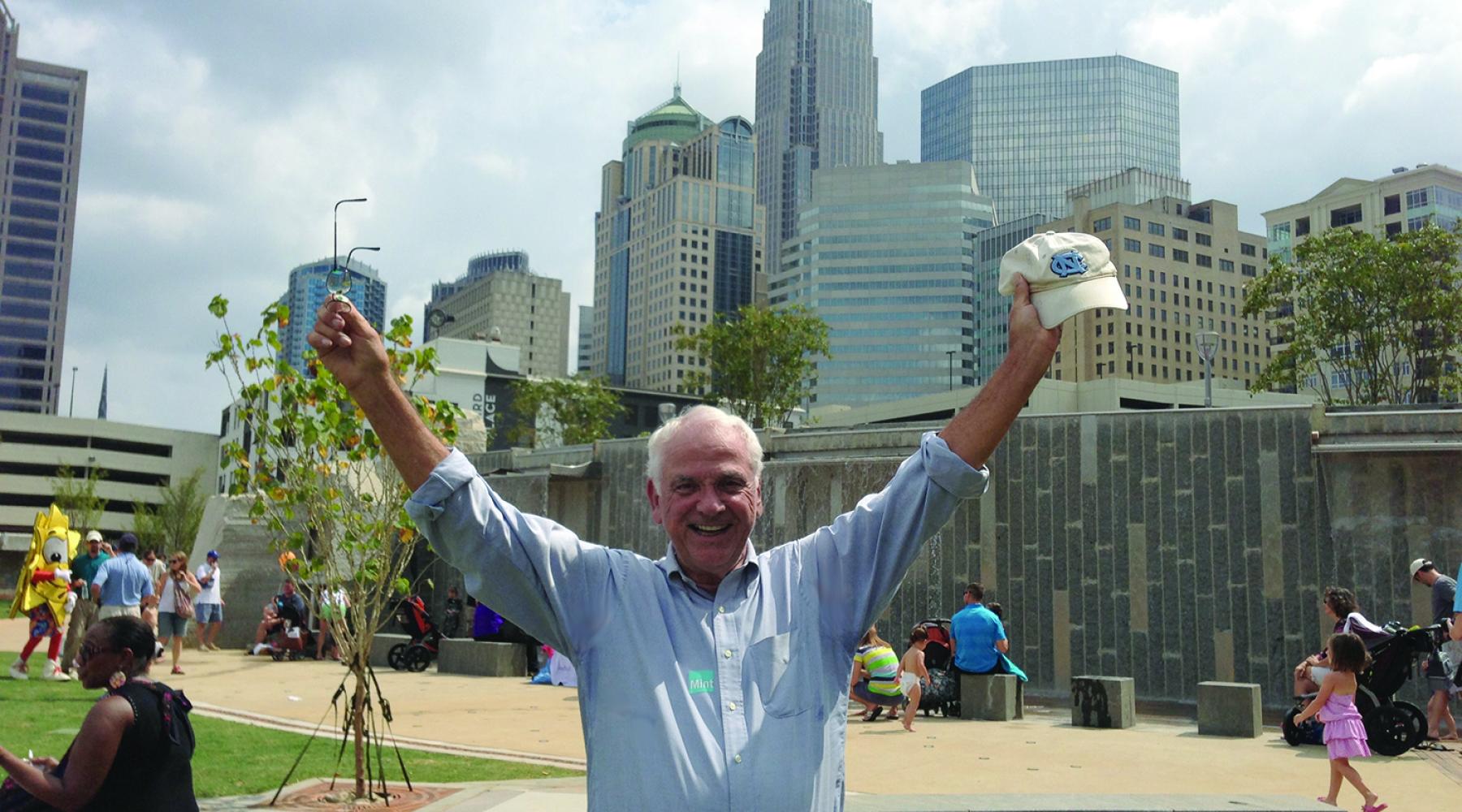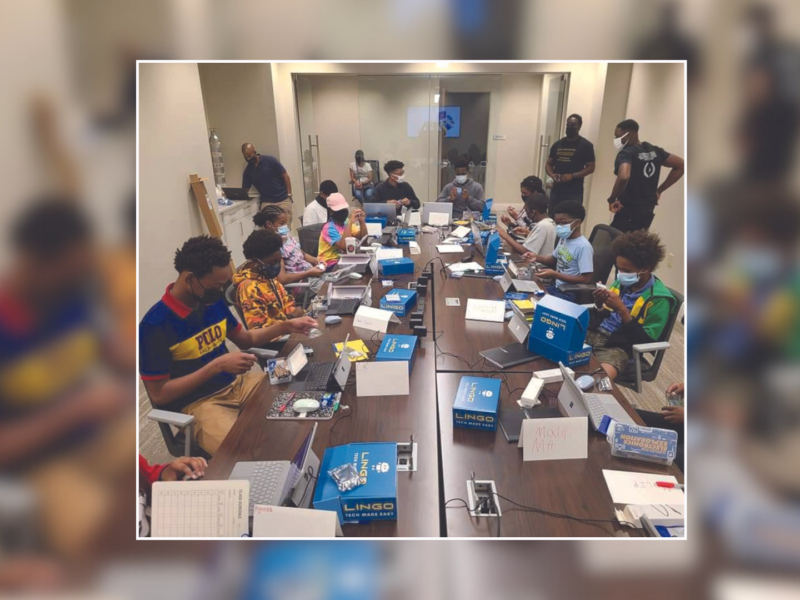
Past, Present and Future
At 89, William Williamson Wants to Continue to Help Shape Charlotte for Decades to Come
The past and present of William H. Williamson III is weaved together closely with the past and present of the city he has called home for most of his 89 years. Born in 1931 at Charlotte’s Presbyterian Hospital (now Novant), Bill Williamson remembers attending a Chamber of Commerce board meeting with his father when he was 7 – back before the city was really a city – where all the men in suits with cigars debated strategy on how to attract more businesses to the burgeoning metropolis. He remembers sitting in the stands of an NFL exhibition game in Charlotte on Dec. 7, 1941, where it was announced at halftime that Pearl Harbor had been bombed. On the car ride home, Williamson remembers his father telling him Charlotte would have its own pro football team some day. He remembers – and still laments – how the bond referendum in the 1970s to expand Charlotte’s airport failed.
He remembers raising money for the at-the-time new Charlotte Arts Fund, which would become the Arts & Science Council. He remembers campaigning for the bond referendum that built Spirit Square and Discovery Place, the first time bonds were approved for cultural projects. He remembers fighting to convince the City to approve an ordinance that ensured the growth of public art in the city.
He also remembers how a $3,000 gift from the United Way was used in 1958 to create the United Community Foundation, which would go on to be known as the Greater Charlotte Foundation and, eventually, Foundation For The Carolinas. Bill Williamson was there for that, too, as one of the first members of the board of directors.
He still serves FFTC, now as an investment committee member, where he uses the knowledge he has accrued through 60+ years as a successful investor at various brokerage firms to advise the Foundation on how best to manage its assets. His relationship with the Foundation is one of the reasons he is leaving half of his estate to the organization he has known all of its life and most of his.
It’s fitting that someone whose life is so closely tied to a city’s past and present would also tie his life to the city’s future – whatever it may be. As Bill Williamson – who made his money making wise choices in an infinite financial sea of risks and unknowns – looks toward tomorrow, he has a plan on how he can continue to shape Charlotte’s future even after he’s gone.
And it’s a lesson he learned at home.
Making A Plan
Williamson lost both grandfathers before he turned 5, but their influence stays with him to this day.
His paternal grandfather, William H. Williamson Sr., was a textile magnate, while his maternal grandfather, William S. Lee, was an electrical engineer who helped start Duke Energy. Both were philanthropists in life and in death.
“(My grandfathers) made planned gifts to support what they cared about,” he said. Williamson Sr. established a foundation with clear parameters on where the money would go – giving annual amounts to Johnson C. Smith University, Davidson College and many others.
His grandfather Lee went in another direction, establishing the William S. Lee Charitable Endowment, which called for his heirs to be trustees of the endowment, entrusting them with the power to determine his legacy. “He wanted to give back to his community, but he wanted to have some guidance about it rather than leave it to the trust department of the bank to give it away,” Williamson said.
The fund was eventually moved to Foundation For The Carolinas, because, as Williamson put it, “if it stayed at the bank trust department in perpetuity it would just be lost in the shuffle.”
Always the leader, Williamson is charting his own path with his legacy. His estate plans include gifts to both FFTC and the UNC Educational Foundation. The portion entrusted to Foundation For The Carolinas will create a permanent endowment in his name, providing for a range of organizations in perpetuity. Among the beneficiaries is FFTC itself. Williamson said he understands how important it is for the Foundation to grow its unrestricted assets, which allows FFTC to meet evolving and changing needs in the community.
This desire to continue to give back – yesterday, today and tomorrow – is an extension of his family motto, “Modice Augetur Modicum,” which means “a little added to a little makes a lot.”
Entering his 10th decade, Williamson still manages most of his money personally. Financial investment is not only what he knows best, but it ensures that every little bit he adds is added to the whole, which will mean a thousand possible futures for the causes he will continue to support after he’s gone.
“I won’t be able to (manage my money) when I’m not here anymore,” Williamson said, “so I need someone like the Foundation For The Carolinas to help me carry that out.”
A Foundation Of Growth
“We didn’t have much in assets,” Williamson said about FFTC in its first few years. “The goal of the board at the time was to build the Foundation up over the years.”
Williamson, a longtime fundholder, served on the Foundation’s board on three separate occasions. But perhaps his biggest contribution to the organization was a lunch he had in 1999.
“In the 1980s and ‘90s, it became evident to those of us on the board that the Foundation had to take a big step forward and try to hire a head person who could take the Foundation to another level,” Williamson said. “I had been serving as president of the Arts & Science Council and was really good friends with (then ASC President & CEO) Michael Marsicano.”
As Williamson tells it, he heard Marsicano was being recruited to leave Charlotte to join an organization in Chicago. So he invited Marsicano to lunch at the Charlotte City Club and asked him if the rumors were true. After confirming them, Williamson made his pitch: “I said, ‘Well, I don’t want you to do that. There’s going to be a great opportunity for you to make a difference in our local community foundation, and I think you’d be the right person to take it to the next level.’”
Marsicano viewed Williamson as one of the most respected civic leaders in Charlotte. So when Williamson invited Marsicano to lunch, he went with an open mind.
“He was so kind and so generous about my work, and he wanted me to stay,” said Marsicano. “I really did not know much about the Foundation. … But I so trusted Bill’s judgement – and he knows me so well – that if he thought it was a good fit, I had to consider it.”
But it was not an easy sell. Marsicano had spent his career up to that point working exclusively in the arts – having come to Charlotte a decade prior after heading the Durham Arts Council – and had no plan to change his path. But Williamson’s determination and guidance made him reconsider.
“I learned that my love for the arts was balanced with my love for this community,” Marsicano said. “The Foundation offered me an opportunity to still have a voice in the arts but also to have a wider influence and impact on the community that I had grown to love. And Bill Williamson was the one who opened my eyes to that possibility.”
When Marsicano took over the Foundation as President and CEO, FFTC assets were $240 million with 1,400 charitable funds. Twenty years later, assets are $2.8 billion and charitable funds have more than doubled to nearly 3,000.
“Right after he accepted the job, I said, ‘Michael, we need to get (our assets) in a short period of time to maybe a half billion dollars,’” Williamson said. “Of course, that was out of the question at the time, but I wanted him to be thinking big about it. And he did.”
Williamson served as president of 10 nonprofit organizations between the ages of 30-75. A tireless volunteer, he recounted being president of the Arts & Science Council when there was only one full-time employee and lots of work to go around. He has spent his life advocating for the causes he believed in, both as a volunteer and as a lobbyist, urging local leaders to see Charlotte for what it could be.
“There was a period that certain people did not want Charlotte to grow and did everything they could to kill it,” Williamson said. “(I wanted people) to wake up and get away from trying to make it a small city. They were worried we’d get big like Atlanta or some place. That was the atmosphere we were dealing in.”
Aiming For The Green
An avid golfer – he was an All American at the University of North Carolina – Williamson usually hits his mark, whether in investment, financial advice or civic leadership.
His love of the links almost led him to turn pro after his military service ended in 1955. He was married, however, and had a child with autism, and Williamson felt the travel would be too much of a burden for his young family. He chose the investment business instead, mainly because he did not know a single thing about stocks or bonds – and did not know how he could manage his money without that knowledge.
Both of his parents died when Williamson was 13, leaving him a small trust fund that he inherited at 25. His uncle, Martin Lee, became a substitute father after their death. It was Lee who encouraged a young Bill Williamson to get involved in the community. Lee was president of the Charlotte Arts Fund and put his nephew to work raising money for local cultural institutions. It began a lifelong dedication to philanthropy, the arts and volunteering.
“Bill is one of the few civic volunteers who does 100 percent of what he says he will do,” said Marsicano. “He does it with commitment. He does it with passion. He studies the issues. He always does his homework. He has got great ideas. But he’s willing to yield his position to the greater good if a different direction is where we need to go.”
Over the years, Williamson has supported a wide-range of causes and organizations: Alexander Youth Network, Mint Museum of Art, McColl Center for Visual Arts, Spirit Square, Charlotte-Mecklenburg Art Commission, Duke Mansion and Central Piedmont Community College Foundation, to name a few. He served more than 20 years on the board of the Daniel Stowe Botanical Gardens. And he cherishes his award as philanthropist of the year from Association of Fundraising Professionals, as well as the Order of the Longleaf Pine.
But the common connection of all of the causes he supports is his hometown, which he helped lead away from where it was in the ‘60s and ‘70s, a mentality he called a “cultural desert.”
In 1986, Williamson helped recruit renown contemporary artist Joel Shapiro to create a public art piece for the new Charlotte Coliseum that was being built on Tyvola Road. The project was budgeted at $275,000 – an unheard of sum for public art in Charlotte at the time. The finished design featured Shapiro’s trademark large rectangle shapes and resembled an abstract athlete in motion. Critics derided it, dubbing it “Gumby” after the green clay cartoon character.
Still, Williamson thought he had the votes to get the project approved. But the City Council rejected Shapiro’s work, choosing an installation by artist Maya Lin instead.
Lin’s “Topo” design featured nine ball-shaped Burford holly bushes arranged on a median. When the Charlotte Coliseum was torn down, “Topo” was lost to the bulldozer. Williamson – still smarting about the defeat more than 30 years later – pointed out that Shapiro’s sculpture could’ve been saved. His work regularly sells in the millions.
“I’ve gotten over it now,” Williamson said with a laugh.
The story sticks with him not because he feels like he was right, but because Williamson – ever mindful of return on investment – knows Shapiro’s sculpture would’ve been good for Charlotte’s future. The uncertainty of what tomorrow might bring has compelled Williamson in his work, in his philanthropy and in his long-term giving plans.
“I’m a patriot of Charlotte, North Carolina,” Williamson said. “I have been all my life. I want to make it a better place. So whatever time I give back – whatever resources I accumulate to give back – makes me feel good. So, I’m doing it.”



